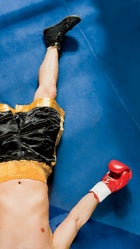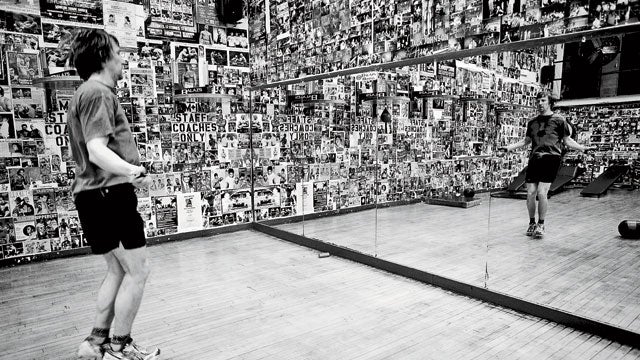“SPAH.”
 Down for the count.
Down for the count.
Huh?
“Spah.”
I'm talking to Caña, my Dominican trainer, as we stand in the center of the Church Street Boxing Gym, a windowless meat locker two stories below ground in downtown Manhattan. Since I've been training here for eight months, three days a week, I'm fluent in Caña's broke-tooth version of English. R's become h's. T's are dropped. “Uppercut” is “oopah-cooh.” And much to my disbelief, Caña is saying that he actually, finally, wants me to engage in glove-to-glove combat to “spar.”
A frizzy-haired macho man in his late thirties who appears to subsist solely on grapes, Caña tosses me a groin protector. On goes the padded diaper, the moronic-looking headgear, the heavy lace-up gloves.
The other people in the gym the heavy-footed Asian and the crazy Cuban shadow boxer, the southpaw heavyweight from Togo and the gym's one (classy, raven-haired, Italian) woman continue their speechless workouts. A few clinch the five leather heavy bags hanging in a line from the grimy ceiling. One person rhythmically paddlewheels a speed bag in the corner while another grabs his sweaty clothes from the bank of creaky metal lockers on the parapet above the ring.
With the A/C either nonexistent or broken, three propeller fans strain to keep the cavernous den less than sweltering in the summertime heat. Faded cutouts from Boxing Digest, newspaper clippings, and old title-bout posters cover the once-white walls, earlier champs staring down stoically, reminding me that boxing is a lonely sport pursued in a crowd.
For months, I've pictured this day with all the anticipation of a debutante imagining her lakeside wedding. I'll take my corner and refuse the small stool, preferring instead to stand and shake out my muscular arms. Just before the buzzer, I'll nod to my cornerman, who'll give me a squirt of water. I'll bump gloves with my brawny opponent and then…bggggt! I'll probably get my ass kicked. But at least I'll have finally sparred, joining the ranks of the mute, nameless badasses I've been training with.
A sound interrupts my reverie: “Hello.”
I turn to face the voice and discover that it's coming from a polite-looking, thirty-something white guy with a goofy smile and bony elbows.
“Where are you from?” he asks.
When I tell him that my great-great-grandparents were from Denmark, he couldn't be more excited. He, too, is from Denmark! He prattles on about this while Caña slaps Vaseline on our faces.
“Did you know that no place in Denmark is farther than 25 miles from the coast?” he says. “You have to visit! The sailing is amazing and “
Caña pushes us toward the ring.
“What's your name?” the Dane asks.
“Eric,” I say.
“Me, too!”
This is so cute. Caña managed to find another white kid, my mirror image, no less.I pass Caña a disgusted look.
“Spah!” he cackles.
A YEAR AGO, I WOULDN'T have been picky about my sparring partner. I didn't even want to fight.
I'd just moved from Boulder to Manhattan, where I realized quickly that I needed a new long-term fitness plan. If, during visits to the West, I was going to continue hanging with my pedal-spinning, trail-stomping, river-running friends the ones who considered moving to a tiny apartment in the city akin to voluntary imprisonment then I needed more than a StairMaster with a view. I needed a genuine Big Apple workout. But what?
The slackers at my coffee shop were no help. They thought happy hour was a sport and that leaving the dinner table once you're full counted as exercise.
I tried parkour (too kitschy), squash (attracts an unsavory crowd), and at a low point swing dancing (seriously). In between, I pedaled everywhere on my 29er mountain bike and rode the subway only to get home after pavement-pounding jogs up the East River. But this wasn't enough. Though my Alphabet City Stuy Town Kips Bay Curry Hill Tudor City Turtle Bay Sutton Place Upper East Side course sounded epic, it measured only about three miles.
I snapped one afternoon in early fall. Checking out the offerings at a friend's fancy $175-a-month gym, I found myself in an exercise room with a phalanx of Carrie Bradshaws, all of us on our backs, scissoring our legs to the beat of grating electro music. “No more chub rub!” enthused Jewel, the boom-miked instructor for the Super Sexy Legs class. “C'mon, girls!”Obviously, I needed something manlier. I'd tried boxing two or three times in Boulder and found it boring, but I decided to give it another chance.
Thank God. On my first visit to Gleason's Gym, I realized that studying the sweet science in a cement-floored warehouse under the Brooklyn Bridge was nothing like boxing in Boulder. The place, one of the most storied gyms in the U.S., reeked of sweat. A bearded man, hunched in the corner, sold plastic toys, odd-size sneakers, and other random merchandise from a folding table. Muhammad Ali and Mike Tyson had prepped for fights at Gleason's, and a swarm of droop-shouldered lounge-abouts hovered near the snack counter, looking eager to swap lies about Yuri Foreman (no relation to George), a Gleason's fighter soon to become the world super-welterweight champion.The fighters working out that afternoon were all limber, powerful, lean, and aerobically fit enough to redline it for 12 three-minute rounds. If these guys couldn't keep up with my buddies on a mountain bike, no one could.
I started right then, spending the first of many hours with one of Gleason's legendary trainers, a former fighter who'd become impressively overweight.
He taught me the basics: the jab used to keep opponents at bay, the straight right used to disarm them, the sneaky hook, the brain-jarring uppercut. I beat the stuffing out of some bags, but only a few weeks later, while doing sit-ups, I began to wonder if my gym dues were simply subsidizing the training of bona fide up-and-comers. I also began to wonder if my pugilistic development was really my trainer's top priority. He sat on my feet on the padded bench used for crunches, absently calling out “58, 59, 60” between bites of pizza.
Not long after, my trainer suggested I spar with a lethal professional.
“But isn't he…that guy?” I whispered, nodding toward a shirtless, dreadlocked bruiser and pointing to a hanging banner celebrating one of his title-fight victories.
“Yuh,” my trainer replied, “and he the only one here that don't got something to prove. I put you in the ring with one of them other guys, they gonna tee off on you.”
I demurred and soon began looking for another gym.
AS A CHILD, I demonstrated a healthy amount of aggression stealing other youngsters' blocks so I could throw them at their heads, shooting at seabirds with a BB gun. But once I hit Catholic school, I grew soft. I played tennis instead of football, and the only thing I fought for was the coveted position of second chair in the Seattle Flute Choir.
In college, I developed a virtuous streak that metastasized into full-blown ASP, or “adult sissy pacifism.” Following in the footsteps of my heroes Thoreau and Muir, I wanted nothing more than to tramp through the Maine wilderness in harmony with every little bird that flitted about. I've always had a fearless streak I'll drop off just about any cliff on skis, and I love to roll back on the throttle of a motorcycle but when it comes to dealing with other people, I'm a chicken. Deep down, I think I just wanted to know if I had the guts to square off against another man.
Church Street promised an answer. Its slogan, printed on T-shirts that never left the dusty display case, was FIGHTING SOLVES EVERYTHING. And while it had recently hosted Puerto Rican great Tito Trinidad, on his way to Madison Square Garden, it also appeared to attract a more diverse crowd than Gleason's, including the occasional chatty blond bruiser from Denmark.
The trainers took an interest in me from the start, despite some initial skepticism about my fitness level.
“A mahathon, really?” Caña asked. Like all boxers, he dreaded road work.
“Yeah,” I said. “Twenty-six miles.”
“You not too…?” Fat? His hands cradled an imaginary beer gut, which apparentlyI had, despite being six feet tall and a lean 175 pounds.
“No, I actually won,” I replied. (True, the race was on an island above the Arctic Circle, and there were only a dozen or so other entrants, but a win's a win.)
“Oh-kaaay,” he said, and not long after that he ripped out three miles on an uptilted treadmill faster than I ever could. (He did it in roughly 16 minutes, wearing a suffocating sauna suit for good measure.)
From then on, either Caña or Jochy, a baby-faced Puerto Rican, or Moises, the gym's hoary grandfather, ran me through drills that haven't changed in 100 years: You warm up by running three miles and skipping rope for a few rounds, shadow-box to find your form, crash the heavy bag to build power, smack the mitts to choreograph your combinations, thrum the speed bag to hone hand-eye coordination, and, finally, rip out at least three sets of 150 sit-ups on a decline board, elbows to knees.
As fall gave way to winter, I diligently repeated this regimen three days a week. My boxing technique remained rudimentary, but I was in great shape. The workouts might sound crude, and pros enhance them with weight lifting and military-style calisthenics, but they're very similar to the ferocious, interval-type workouts you'll find at more progressive gyms.
Over time, my dedication to the sport spread beyond the gym. I watched a few fights, including Golden Gloves bouts in Madison Square Garden and the low-budget Friday-night fights in the basement of a church on the Upper West Side. I studied YouTube instructional videos and became that idiot who, after a few drinks and much to his girlfriend's dismay, challenges his friends to late-night demonstrations of the martial arts. (My best jab, I learned, did not defend against the kung fu sweep kick.) At home, I dove into the diverse canon of boxing literature King of the World, by David Remnick; The Fight, by Norman Mailer; On Boxing, by bird-size novelist and unwincing Tyson fan Joyce Carol Oates.
In the gym, the routine of jab-jab-right-left hook-right grew tedious, but the heavy bag became a constant companion. Sometimes I hated the pendulous lump; other times I loved it, thankful that to succeed with it required nothing more than willpower.
And the fitness results were undeniable. When late winter rolled around, I met up with friends at Silverton Mountain, the experts-only backcountry ski area in western Colorado. As we bootpacked around the 13,500-foot summit looking for fresh snow, not only was I able to keep up with my superfit buddies; I even dropped a few of 'em. As they shook their heads and wheezed, I punched at the clouds and humbly celebrated my success: “I'm the greatest!”
PERHAPS I SHOULD HAVE left that unsaid. Back at Church Street, when it finally comes time to step into the ring, the only title I deserve is “the greenest.” Eric and I duck the ropes at opposite sides of the sprung stage. Jochy, my cornerman, sprays some water in my mouth, just like I imagined, and then informs me that I'll be going four rounds.
The point of sparring is to practice your combinations, get a feel for how to move around the ring, test your stamina. Or so says the Internet. As best I could tell from the few sessions I've watched, the basic rules are this: It's OK to flatten your opponent's nose; just don't break any ribs.
“Chin down, hands up,” is all Jochy says.
The buzzer rings, I bump gloves with Eric, who's still smiling dopishly, and then I step back from the center of the red canvas.
While I focus on finding my form standing squarely on both feet, rear foot slightly splayed Eric starts punching me. Hard. Mostly in the face, but occasionally opting to switch it up and lodge a few in my gut. I do my best to protect myself, crouching into a turtle shell, but his punches always seem to find tender tissue.
As soon as his blows land on my mug, my eyes crimp shut and I feel the shock radiate from cheekbones to ears. My neck strains to keep my head on. Nothing in my personal history has prepared me for this, and I'm really disappointed. Punching me in the face? That is not Danish behavior.
After three minutes, round one ends.
I haven't thrown a single punch.
“Move!” Jochy exhorts, a single brilliant syllable cutting through the fog.
In round two, I move, striding clockwise, so that now his ample, forceful, surprisingly painful punches send me teetering. The canvas is the deck of a ship in a storm. My chest aches, my face feels swollen.
Maybe I can pull the rope-a-dope, I tell myself. Like Ali playing Foreman in Zaire, the famous Rumble in the Jungle, I'll let my opponent wear himself out.
And that's what happens or so it appears. In round three, I come out swinging, and he hardly puts up a fight. After two jabs, my right hook lands. I sink a body blow, pop him in the kisser, and then something lets loose inside and I go berserk, flailing, arms windmilling, pitty-pat punching and slapping his ears and forearms.
“Get him!” someone yells, and I don't know which Eric they're cheering, but I keep after him as he turns his back to me and runs. Literally.
In the last round, however, it becomes clear that he wasn't exhausted; he was just practicing his defense. I bob and weave straight into his fists. I open my eyes just in time to see the next blow landing, like a surfer coming up for air only to find another wave crashing down on him, and can't summon the guts to fight back. Eye of the tiger? More like eye of the hamster.When it ends, the shit thoroughly beaten out of me, I brusquely shake Eric's hand, throw off my protective gear, and grab Jochy.
“What do I need to do to make sure I never get hit like that again?” I ask.
In his dramatically abbreviated way, his answer echoes Joyce Carol Oates's in On Boxing, when she writes that the best boxers are the ones who want to get beaten up.
“Everybody gets hit,” he says.
Caña cackles and throws a not-so-soft punch at my stomach. I walk out.
It's a beautifully sunny day, and across the street a fire hydrant is gushing water. I douse my sweat-soaked head, rinse my cuts, and shake. Two weeks later, I let my membership expire.


